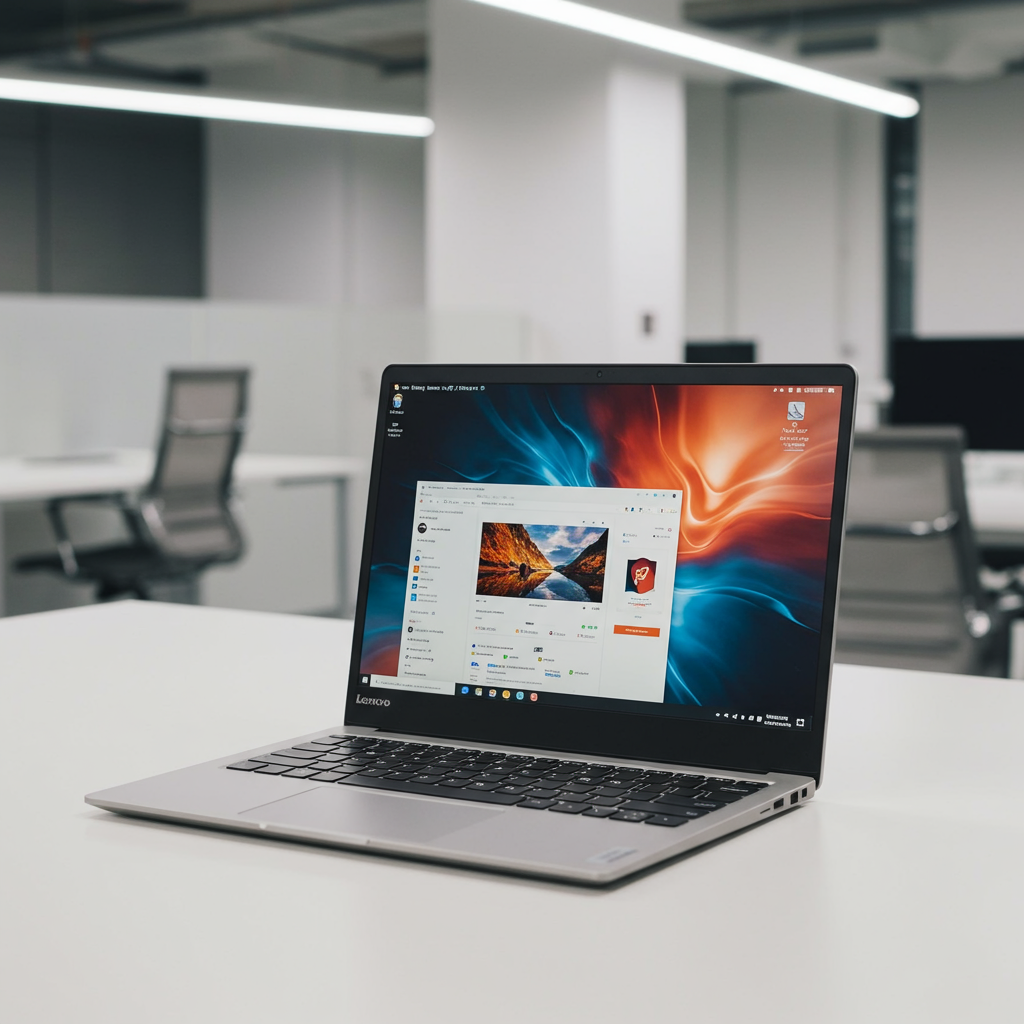Stepping into the realm of premium yet affordable laptops, the lenovo chromebook Plus 14 emerges as a compelling contender. This ARM-powered device promises a fantastic user experience built around a stunning OLED display, robust performance for everyday tasks, and truly impressive battery life. Priced starting at just $649 (with a loaded touchscreen version at $749), it packs features often found in significantly more expensive machines, positioning itself as a potential frontrunner in the Chromebook space. Is this the upgrade ChromeOS users have been waiting for? Let’s delve into what makes this model stand out.
Unpacking the Lenovo Chromebook Plus 14: Specs and Design
The Lenovo Chromebook Plus 14 doesn’t immediately scream premium from its exterior. Its appearance is best described as functional and perhaps a bit understated. Yet, beneath the surface lies a well-constructed machine designed for portability and usability. Weighing in at a manageable 2.78 pounds (for the touchscreen model) and measuring a svelte 0.62 inches thin, it’s easy to carry around throughout the day. The build feels solid, lacking significant flex despite its lightweight nature.
Premium Feel on a Budget?
While the aesthetic might be plain, the tactile experience tells a different story. The keyboard, a hallmark of Lenovo laptops, is excellent. Typing feels comfortable and responsive, easily matching the quality found on much pricier notebooks from the brand. The touchpad, while adequately sized, receives less praise. Its mechanical click is notably loud and feels somewhat cheap, a minor detractor from an otherwise solid build. There’s also the matter of a couple of potentially annoying “ugly stickers” to remove if you prefer a clean look.
Port Selection: Functional, But Not Cutting Edge
Connectivity is handled by a practical, if not blazing-fast, assortment of ports. You’ll find two USB-C ports and one USB-A port, alongside a standard 3.5mm audio jack. A convenient design choice places one USB-C port on each side, making charging straightforward regardless of your setup. While these ports are rated at a modest 5Gbps speed, the USB-C connections do support DisplayPort 1.4 and Power Delivery 3.0. This allows the Chromebook to drive up to two external 4K monitors simultaneously, a useful capability for expanding your workspace. A fingerprint reader on the $749 model adds a layer of convenient security.
The Star of the Show: A Stunning OLED Display
The undeniable highlight of the Lenovo Chromebook Plus 14 is its display. It features a 14-inch OLED panel with a resolution of 1920 x 1200. While the resolution and 60Hz refresh rate are standard, the OLED technology elevates the visual experience dramatically. Colors are incredibly vibrant and punchy, and contrast is exceptional, delivering deep blacks and bright whites that make content pop.
This screen is available even on the base $649 configuration, a significant value proposition. The review unit at $749 adds touchscreen functionality. Compared to competitors, getting an OLED panel of this quality at this price point is a major win. The 16:10 aspect ratio is also a welcome departure from older 16:9 panels, offering more vertical screen real estate for productivity.
Performance Powerhouse (for a Chromebook): MediaTek Kompanio Ultra 910
Under the hood, the Lenovo Chromebook Plus 14 is powered by an ARM-based MediaTek Kompanio Ultra 910 processor. The review configuration boasts a generous 16GB of LPDDR5X RAM and 256GB of fast UFS 4.0 storage. This combination provides a noticeable performance boost over many standard Chromebooks, feeling consistently snappy for everyday tasks.
The system operates silently thanks to a fanless design, much like a MacBook Air. The 8-core MediaTek chip, paired with ample RAM, handles extensive multitasking with ease. Running numerous Chrome tabs across multiple virtual desks, streaming music via the Android app, and even handling background tasks like uploading documents to AI services didn’t cause the system to break a sweat during testing. Achieving noticeable slowdowns was rare and typically required deliberate stress tests. The Kompanio Ultra 910 also includes an AI NPU, capable of 50 TOPS, which supports the growing suite of AI features available on Chromebook Plus devices.
Real-World Multitasking Prowess
For typical ChromeOS workloads, the Lenovo Chromebook Plus 14 delivers impressive responsiveness. Swapping between dozens of tabs, managing multiple windows, and running a mix of web-based applications and Android apps felt fluid. The 16GB of RAM, double or more than many competitors, is clearly beneficial here, preventing slowdowns often encountered with complex web pages or multiple open applications. It demonstrates that ChromeOS, when paired with robust hardware like this, is more than capable for demanding productivity flows.
Understanding ARM Limitations
While powerful, the ARM architecture does introduce some potential compatibility quirks, particularly for certain Linux applications. The review noted significant issues with Zoom across various versions (browser, Android, PWA), describing it as unreliable. The Linux version of Slack also proved incompatible as it wasn’t compiled for ARM chips, forcing reliance on the browser version. While most users will live primarily within the web or Android ecosystem where compatibility is strong, those planning heavy use of specific Linux apps should verify their ARM support beforehand.
Battery Life That Goes the Distance
Equipped with a 60Wh battery and a power-efficient ARM chip, this Lenovo notebook is a battery champion. While Lenovo claims up to 17 hours, real-world use confirms exceptional longevity. The reviewer experienced comfortable multi-day use with moderate workloads. Starting a workday around 8 AM with 77% charge, using the laptop consistently for about nine hours through until 5 PM still left around 20% battery life remaining. This kind of stamina means you can confidently leave the charger at home for a full day out.
Input Experience: Hits and Misses
The user interaction points present a mix of triumphs and minor frustrations. As mentioned, the keyboard stands out as genuinely excellent, offering a comfortable and precise typing experience typical of Lenovo’s high standards. Audio performance from the speakers is quite good, delivering full sound for music and podcasts and capable of getting reasonably loud.
However, the webcam, while a respectable 5 megapixels with a privacy shutter, suffered from a greenish tint in testing. It’s functional for video calls but not exceptional. The trackpad, while a decent size, has a mechanical click that is loud and feels inexpensive, detracting slightly from the otherwise solid feel of the device.
Chromebook Plus: What Does It Really Mean Here?
The Lenovo Chromebook Plus 14 fully embraces the “Chromebook Plus” initiative, a standard set by Google to guarantee a baseline of modern hardware and enhanced software features. This model exceeds the minimum requirements (12th Gen Intel Core i3 / AMD Ryzen 3 7000 or better CPU, 8GB+ RAM, 128GB+ storage, 1080p+ display, 1080p webcam with TNR).
Beyond the specs, Chromebook Plus brings tangible benefits. This device supports advanced features like enhanced Google Photos editing (including Magic Eraser). It also benefits from exclusive AI capabilities like Smart Grouping for organizing tabs into virtual desks and AI image editing within the Gallery app for tasks like background removal. Broader Chromebook Plus AI features include a quick screen area search via a long-press, Text Capture to extract and act on text in images, and an enhanced Quick Insert key for generating AI images in text fields. Additionally, buying this Chromebook Plus model currently includes a valuable 12-month subscription to Google One AI Pro, offering 2TB of storage and access to advanced Gemini AI features. Google also promises extensive software support, potentially lasting up to 10 years.
Value Proposition and Competition
Priced at $749 for the well-equipped touchscreen version (or $649 for the base OLED model), the Lenovo Chromebook Plus 14 presents remarkable value. It directly competes with other Chromebook Plus flagships like the Acer Chromebook Plus Spin 714 and the Samsung Galaxy Chromebook Plus.
Crucially, the Lenovo model offers 16GB of RAM (in the $749 config) and a superior OLED screen at a price point that is often lower than competitors with less RAM or standard IPS displays. While the Acer Spin 714 offers a versatile 2-in-one design and strong performance (often with an Intel Core i5), the Lenovo counters with more RAM and that standout OLED. The Samsung Galaxy Chromebook Plus also has an OLED, but uses a less preferred 16:9 aspect ratio screen and has a cramped keyboard layout. The Lenovo’s combination of high-end specs, particularly the RAM and display, for its price makes it a compelling option. While the overall high-end Chromebook market ($999+) has seen some struggles, this model hits a sweet spot of premium features without crossing that higher price threshold.
Frequently Asked Questions
What makes the Lenovo Chromebook Plus 14 stand out from other Chromebooks?
Its main distinction lies in offering premium features typically found on more expensive laptops at a competitive price. Key highlights include a stunning 14-inch 1920×1200 OLED display with exceptional color and contrast, ample 16GB of RAM (on the $749 model) providing excellent multitasking performance for ChromeOS, and outstanding battery life. These features, combined with a great keyboard and solid build, deliver significant value for the cost.
What kind of performance can I expect from the MediaTek Kompanio Ultra 910 chip?
The ARM-based MediaTek Kompanio Ultra 910, especially paired with 16GB RAM in the reviewed configuration, offers robust performance for typical Chromebook tasks. It excels at handling numerous Chrome tabs, running Android apps, and managing web-based productivity suites simultaneously in a fanless, silent design. While it’s highly capable for everyday use and multitasking, users relying heavily on specific, demanding Linux applications might encounter compatibility issues if the software isn’t compiled for ARM architecture.
Does the Lenovo Chromebook Plus 14 include any special software or features?
Yes, as a Chromebook Plus device, it comes with enhanced features beyond standard Chromebooks. It supports advanced Google Photos editing and features exclusive AI tools like Smart Grouping for tabs and AI image editing in Gallery. Other AI features coming to all Chromebook Plus models include Text Capture and an enhanced Quick Insert key for AI images. Purchasing this model also includes a valuable 12-month Google One AI Pro subscription with 2TB storage.
Conclusion
The Lenovo Chromebook Plus 14 is more than just another ChromeOS laptop; it’s a statement piece that redefines value in this category. With a breathtaking OLED display that serves as its centerpiece, coupled with surprisingly capable performance from the MediaTek Kompanio Ultra 910 and 16GB of RAM, and battery life that genuinely lasts for days of typical use, this device checks an impressive number of boxes.
While minor quibbles exist with the touchpad click, webcam tint, and port speeds, they are overshadowed by the device’s strengths and aggressive pricing, especially when considering the cost of competitors offering fewer features. It feels like a spiritual successor to Google’s beloved Pixelbook, offering a premium experience without the Pixelbook’s high price tag. For anyone seeking a reliable, high-performance Chromebook with a truly exceptional screen for productivity, streaming, and general use, the Lenovo Chromebook Plus 14 stands out. It doesn’t just compete; it sets a new standard, making it a strong contender for the title of the new king of Chromebooks and simply a great computer overall.
Word Count Check: ~1150 words




